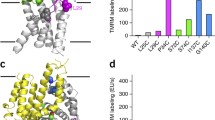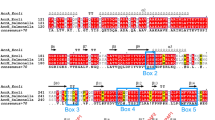Abstract
A chimeric transport protein was made by expression of a fusion of thearsB genes fromEscherichia coli plasmid R773 andStaphylococcus aureus plasmid pI258. The two genes were fused to encode a functional protein with first eight membrane spanning α-helices of theS. aureus and the last four helices of theE. coli protein. The hybrid protein provided arsenite resistance and transport. When anarsA gene was expressed in trans with the ArsB proteins encoded by the R773, pI258 and fusion genes, arsenite efflux was dependent on chemical but not electrochemical energy. The Ars system is hypothesized to be a novel transport system that functions as a primary ATP-driven pump or a secondary carrier, depending on the subunit composition of the complex.
Similar content being viewed by others
References
Bröer S, Ji G, Bröer A & Silver S (1993) Arsenic efflux governed by the arsenic resistance determinant ofStaphylococcus aureus plasmid pl258. J. Bacteriol. 175: 3480–3485
Butlin JD, Cox GB & Gibson F (1971) Oxidative phosphorylation inEscherichia coli K12. Biochem. J. 124: 75–81
Chen C-M, Misra T, Silver S & Rosen BP (1986) Nucleotide sequence of the structural genes for an anion pump: the plasmid-encoded arsenical resistance operon. J. Biol. Chem. 261: 15030–15038
Chen C-M, Mobley HLT & Rosen BP (1985) Separate resistance to arsenate and arsenite (antimonate) encoded by the arsenical resistance operon of R-factor R773. J. Bacteriol. 161: 758–763
Henderson PJ (1990) Proton-linked sugar transport systems in bacteria. J. Bioenerg. Biomemb. 22: 525–69
Hsu CM & Rosen BP (1989) Characterization of the catalytic subunit of an anion pump. J. Biol. Chem. 264: 17349–17354
Ji G & Silver S (1992) Regulation and expression of the arsenic resistance operon fromStaphylococcus aureus plasmid pl258. J. Bacteriol. 174: 3684–3694
Kaur P & Rosen BP (1992) Plasmid-encoded resistance to arsenic and antimony. Plasmid 27: 29–40
Kyte J & Doolittle RF (1982) A simple method for displaying the hydropathic character of a protein. J. Mol. Biol. 157: 105–132
Maniatis T, Fritsch EF & Sambrook J (1982) Molecular cloning, a laboratory manual, Cold Spring Harbor Laboratory, Cold Spring Harbor, New York
Miller J (1972) Experiments in Molecular Genetics. Cold Spring Harbor Laboratory, Cold Spring Harbor, New York
Mobley HLT & Rosen BP (1982) Energetics of plasmid-mediated arsenate resistance inEscherichia coli. Proc. Natl. Acad. Sci. USA. 79: 6119–6122
Oden KL, Gladysheva TB & Rosen BP (1994) Arsenate reduction mediated by the plasmid-encoded ArsC protein is coupled to glutathione, Molec. Microbiol. In press
Rinchik EM, Bultman SJ, Horsthemke B, Lee ST, Strunk KM, Spritz RA, Avidano KM, Jong MT & Nicholls RD (1993) A gene for the mouse pink-eyed dilution locus and for human type II oculocutaneous albinism. Nature 361: 72–76
Rosen BP & Borbolla MG (1984) A plasmid-encoded arsenite pump produces arsenite resistance inEscherichia coli. Biochem. Biophys. Res. Commun. 124: 760–765
Rosen BP, Weigel W, Karkaria CE & Gangola P (1988) Molecular characterization of an anion pump. ThearsA gene product is an arsenite(antimonate)-stimulated ATPase. J. Biol. Chem. 263: 3067–3070
Rosenstein R, Peschel P, Wieland B & Götz F (1992) Expression and regulation of theStaphylococcus xylosus antimonite, arsenite and arsenate resistance operon. J. Bacteriol. 174: 3676–3683
San Francisco MJD, Hope CL, Owolabi JB, Tisa LS & Rosen BP (1990) Identification of the metalloregulatory element of the plasmid-encoded arsenical resistance operon. Nucl. Acid. Res., 18: 619–624
Silver S & Keach D (1982) Energy-dependent arsenate efflux: the mechanism of plasmid mediated resistance. Proc. Natl. Acad. Sci. USA 79: 6114–6118
Tisa LS & Rosen BP (1991) Molecular characterization of an anion pump: the ArsB protein is the membrane anchor for the ArsA protein, J. Biol. Chem. 265: 190–194
Wu JH, Tisa LS & Rosen BP (1992) Membrane topology of the ArsB protein, the membrane component of an anion-translocating ATPase. J. Biol. Chem. 267: 12570–12576
Wu JH & Rosen BP (1993) ThearsD gene encodes a secondtrans-acting regulatory protein of the plasmid-encoded arsenical resistance operon. Molec. Microbiol. 8: 615–623
Author information
Authors and Affiliations
Rights and permissions
About this article
Cite this article
Dou, D., Dey, S. & Rosen, B.P. A functional chimeric membrane subunit of an ion-translocating ATPase. Antonie van Leeuwenhoek 65, 359–368 (1994). https://doi.org/10.1007/BF00872219
Issue Date:
DOI: https://doi.org/10.1007/BF00872219




